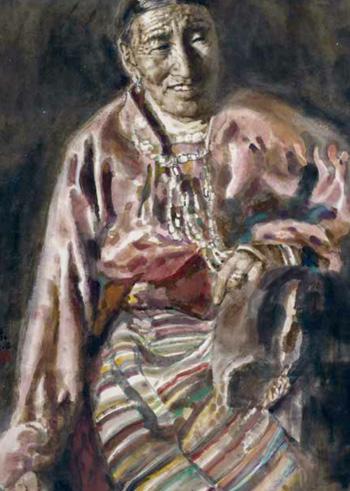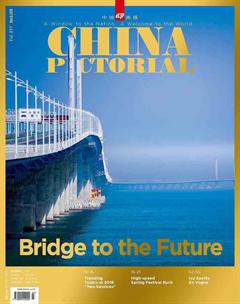Portrait of Modern Chinese Painting Wang Xijing’s Ink
by Shao Dazhen
Wang Xijing, born in Xian in Chinas northwestern province of Shaanxi in 1946, is a member of the China Artists Association (CAA) and the Chinese Painting Art Committee under the CAA. He serves as deputy director of the Chinese Painting Institute and part-time professor at the Chinese National Academy of Arts. He is also a member of the 12th National Committee of the Chinese Peoples Political Consultative Conference(CPPCC) and a deputy to the 9th and 10th National Peoples Congress (NPC).
He has held more than 30 exhibitions in Britain, France, Singapore and elsewhere and won numerous honors and awards at home and abroad, including the title of “National Expert with Outstanding Contributions”from the State Council of China and the special award of the annual international Salon exhibition in the Louvre.
Considered one of Chinas most representative figure painters by Liu Dawei, president of the CAA, Wang Xijing and his work have exerted a profound influence on the development of Chinese figure painting.
After studying his ink and wash paintings and following his artistic development path over the decades, it is clear that Wang is a painter with cultural self-consciousness and the ability to advance with the times. His works reflect the changes of his times from social consciousness to aesthetic ideals. And his personal aesthetic tendency reflects his deep understanding of traditional Chinese art.
Wang Xijing began working after graduating from art school in 1968. By copying ancient figure paintings and comic paintings, he honed his skills, especially in linebased Chinese painting.
From 1969 to 1974, he created two outstanding comic books, The Vietnamese Heroine and Arrows Whistling through the Forest, which raised eyebrows in art and comics circles.
In 1978, he edited and published the book Techniques of Line-Drawing in Chinese Figure Painting, which systematically introduced and detailed line-drawing techniques of traditional figure painting. The work also demonstrates that Wang understood the value of traditional Chinese painting earlier than his peers.
In the 1980s and 1990s, the collision between Chinese and Western arts exerted a profound influence on traditional Chinese art, transforming it into modern art, especially the field of figure painting.
Creating “new-style” ink and wash figure paintings with both strong traditional Chinese style and modern appeal is a difficult but worthwhile art project that requires continuing efforts of artists across generations.
When Wang began exploring the realm of modern figure painting, he recognized this problem. By studying a series of historical figure paintings, he gradually devised a method to solve it. Disappearing Footsteps, a work completed in 1984, most distinctly embodies his achievements during this era.
After the mid-1980s, Wangs understanding of the traditional cultural spirit as well as the unique concepts and skills of Chinese painting deepened exponentially. New artistic pursuits and drastic changes in artistic style can easily be pinpointed in his work during this period of time.
In a series of historical figure paintings represented by Chinas Revolutionary Leaders and Lu Xun(1881-1936, contemporary Chinese writer and thinker), he placed more focus on increasing the expressive force of the lines and the role of void in the layout, strategies more in line with freehand brushwork and traditional Chinese cultural spirit. He concealed realism while allowing it to still be felt, especially in character-shaping.
Wang Xijing attributes the change in style to the accumulation of practical experiences and a new understanding of Chinese painting. From a wider perspective, it is the logical evolution of Chinese painting that combines “old” (ancient Chinese painting tradition including literati painting) and “new” (tradition since the May Fourth Movement).
We must face the fact that contemporary Chinese figure paintings are rooted in the profound tradition of Chinese culture and art. However, this does not mean that we should simply cling to the old way, but instead draw important nourishment from profound cultural traditions such as literati painting. New-style realistic figure paintings must reflect the Chinese spirit.
Wang Xijing clearly grasps the essence of the problem and seriously considers the important concepts of “Chinese tradition,”“time” and “personality.”
This is why the change in his painting style is natural. We can see that many of his figure paintings feature ancient literati or poets and place particular attention on the usage of traditional ink painting techniques. More importantly, these paintings feature the most distinctive characteristics of Wang Xijing: fresh style and elegant, vivid and robust images.
By deeply understanding the philosophy, style and skills of traditional Chinese art while maintaining a broad cultural vision, Wang Xijing has developed the belief that an artist should make efforts to bridge traditional and modern arts. To create modern Chinese painting art, he is constantly thinking and creating. Some of his works have transcended the scope of figure painting, showing artistic conception with concise, implicit or even obscure techniques, reflecting his feelings about life, history and the universe. He is dedicated to exploring the infinite possibilities of freehand brushwork in Chinese ink and wash painting.

